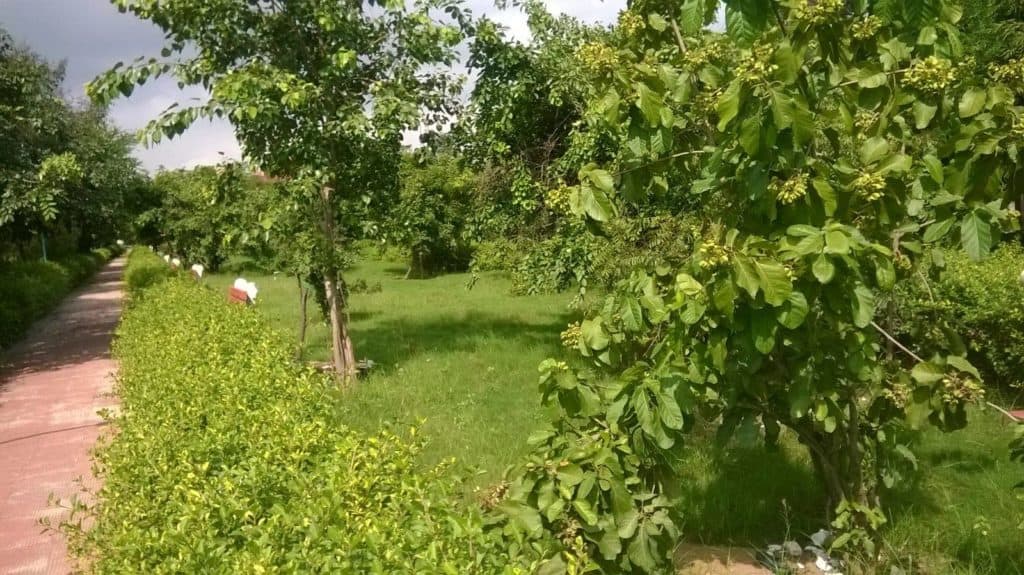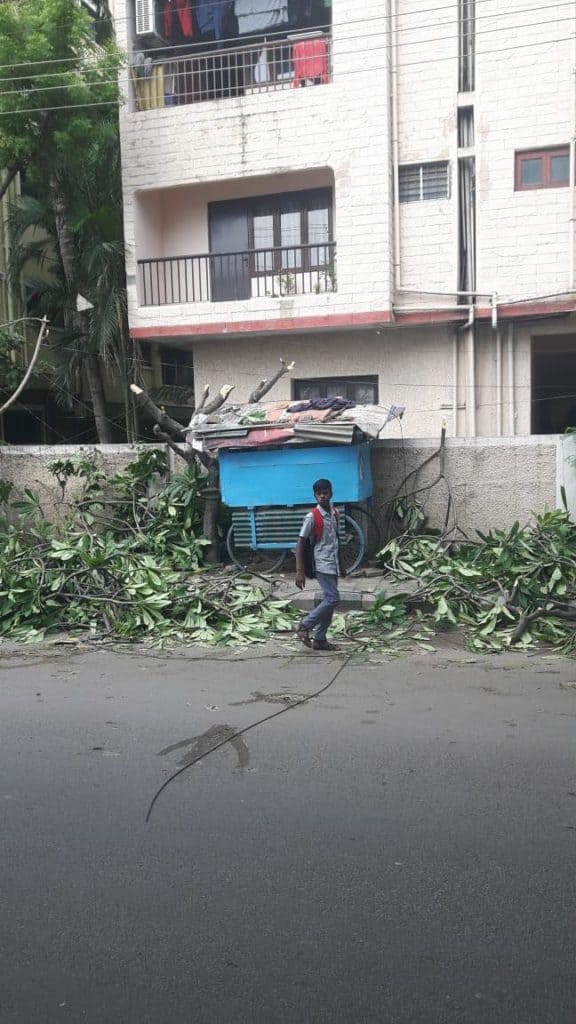A distraught resident from a neighbourhood in Chennai called Nizhal recently to help resolve an issue. Her 40 year-old naval/jamun tree had over the years grown to reach out toward their neighbours’ home. Now the neighbours were insistent that the entire branch be chopped off or the entire tree felled!
She had several questions she wanted answers for: Could the chopping cause an imbalance or fungal infection to the trees? Would the tree be easier to kill when the branch is chopped? How could Nizhal support in protecting the tree? She also wanted to know if there was a government authority that she could approach to protect the tree.
Who has rights over trees?
This was just one among thousands of similar phone calls we have received over the 15 years of our NGO’s existence. My heart sank as I responded that all trees within private campuses were the official property of the registered owner, and so anyone could do with them as they wished .
On public roads, the officials of the Greater Chennai Corporation were in charge. They make decisions on whether a tree can stay or not, depending on whether they are sensitive to tree concerns or not.
Since a mature tree on a public road is considered public property, indiscriminate cutting can be booked under the Prevention of Damage to Public Property Act 1984 with local police stations. Sadly, in most cases, where a tree guardian spoke up for a mature tree in a public space, local police officials were observed to be not very supportive.
We have come across many instances where they brushed off the issue or those who spoke up were talked down to, as they (the officials) didn’t consider the issue important enough.

In some cases the monetary value of this ‘public property’, the tree, was pegged at a minimal value of about Rs 50 so that the fine levied against those who caused destruction could be minimal. If pressured, a Community Service Register Number would be generated but in almost all cases, no further action is taken.
What we lose when we lose a tree
Imagine a mature tree on the roadside, with its bounteous shade and life giving oxygen, mitigating pollution and reducing carbon footprints for so many years to benefit all the humankind and fauna around, providing shelter for weary pedestrians and homes for birds, insects and squirrels.
Older tree ecosystems are greater contributors to societal and environmental well being. Planting ten young saplings to replace a mature tree with a large canopy, which is an oft-suggested remedy when a tree is felled, actually cannot serve the purpose at all. It may be effective only after a decade, when the trees grow up, and that too, if they have been planted in the same area. Else, it is just a convenient excuse to continue the status quo.


Meanwhile thousands of magnificent tree veterans fall by the wayside alongside the highways that crisscross the State. Most citizens believe ornamental palms can replace the ecosystem services of a venerable Iluppai or Magizham. That cities need biodiversity to maintain life-supporting systems and essential ecological processes is rarely understood.
Transplanting is touted as a viable option. But the process itself is laborious and expensive and unless adequate pre and post care is ensured, the transplanted trees may not survive. Also, the success of the process depends on the age of the tree, the species and quality of pre and post care. There is no ongoing audit in most places for how many of the transplanted trees have been revived.
Absence of tree act or tree authority
Since its inception in 2005 the team at Nizhal has been calling for an Urban Trees Protection and Preservation Act for Tamil Nadu. The late Mr. Dattatri, our Chief Advisor and first town planner of the city of Chennai, pored over several possible urban scenarios to draft a protection network for mature trees across Tamil Nadu, in consultation with legal experts. Drafts of our recommendations were sent to authorities and even the Chief Minister’s office. We have raised this issue on various platforms and through the media, but with little progress.
Sometime in 2010, then Minister of Environment and Forests announced that a Tree Preservation Act would be passed soon in Tamil Nadu. But this law has still not seen the light of day. Meanwhile both private and government bodies continue to ‘remove’ trees in the name of development and for minor inconveniences.
Many public interest litigations and writ petitions have been filed at various points in different parts of the State by petitioners concerned about rampant felling, particularly with regard to state highways. And the High Court of Madras has time and again stood up for the tree safety cause.
However, a positive shot in the arm for mature trees surfaced when a writ petition was filed by one Kubendran of Madurai, who sought relief against trees being cut indiscriminately for the purpose of constructing a highway bridge. Nizhal was suo motu impleaded by the division bench. In response to this petition, the court directed the Madurai Corporation to look into other alternatives to conserve trees instead of felling them for development activities. This ruling has given some solace to these silent green victims of ‘development’ across urban spaces.
If passing a comprehensive Tree Act is expected to take more time, a Tree Authority or Tree Committee must be instituted by the Municipal Corporations, until such a time that the law is passed. Urban areas are spaces where mature trees are in gravest danger from ‘development’. A competent authority could ensure a system and process to ensure the safety of mature trees.
States that took the lead
Fortunately, some states in India have been more progressive: Maharashtra, Karnataka, Andhra Pradesh have instituted Tree Preservation Acts which have been in place since the 1970s.
According to the Maharashtra Tree Act, a Tree Authority looks into various issues involving trees that include –
a) Protection and preservation of all trees in all lands within jurisdiction.
b) Carrying out a Census of existing trees on all lands every five years
c) Prescribing standards specifying the number and type of trees each plot of land should have
d) Development and maintenance nurseries for the supply of seeds, saplings of trees to those wishing to plant new or replace felled trees
e) Transplantation of trees because of road construction or for safeguarding against danger to life and property.
f) Organising vegetable and flower shows yearly to raise consciousness about trees and vegetation for human welfare. Assisting private and public institutions in organizing such shows, and creation of consciousness of importance of trees and vegetation to human welfare.
g) Giving advice and assistance to those who seek it in any matter connected with planting, protection and preservation of trees
h) Planting and maintenance trees as considered appropriate according to prescribed standards in public places such as along the roads, river banks, lakes, public parks and gardens.
i) Undertaking ANY schemes considered necessary for achieving objectives of the act.
This Tree Authority includes the Chairman and 5-15 other appointed members, approved by the general body and also representatives from non-official organizations who are knowledgeable and experienced in the field of planting and preservation of trees.
Status in Chennai & Tamil Nadu
Over the years, in Chennai and other urban areas in Tamil Nadu, both governmental and non governmental bodies have struggled to green the city in the face of a host of challenges – apathy and vandalism, scarcity of water or funds.
Sadly, even after a tree has attained maturity having successfully crossed all these hurdles, they cannot be assured protection. The lack of a broad legal framework to address this critical issue incapacitates both the sensitive official and the caring citizen.
In Chennai, the Greater Chennai Corporation came up with a landmark notification to levy hefty fines on all forms of tree abuse, but follow up and reinforcement needs to get stricter.
How can the state of Tamil Nadu lag behind in such a vital area? Can we continue to let the destruction of mature trees continue, with no protection for even the rarest of rare species? Anyone can decimate them at any time regardless of whether it stands on private or public property.
How many citizens really care enough to raise a call for these voiceless sentinels and purifying lungs of our polluted cities? Will there ever be a time when we all collectively stand up for trees in our cities? Simply because our lives and well-being depend on theirs.
Also read: